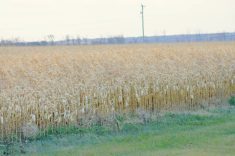Fields finally got a break in the dry spell coming into the third week of June, although some more than others.
Manitoba Agriculture reports that much of agro-Manitoba got less than 60 per cent of average moisture between May 1 and June 9, although much of the east and Red River Valley were creeping closer to 80 per cent or above thanks to rains June 8.
The southwest, however, sat below 40 per cent of normal rain in that time frame, numbers that have improved little in some areas, even with rains June 15-16.
Read Also

Manitoba sclerotinia picture mixed for 2025
Variations in weather and crop development in this year’s Manitoba canola fields make blanket sclerotinia outlooks hard to pin down
Areas around Brandon added another 25 millimetres of rain June 15-16, the most substantial rain the area has seen yet this season, while areas farther north along the Saskatchewan border saw similar rain.
Precipitation dwindled to the east and north, however. Winkler and Carman saw around 10 millimetres and precipitation had largely trickled off by the east edge of the Red River Valley. The Interlake, likewise, was still dry. The region had still seen less than 20 millimetres in June as of June 17, according to Manitoba Agriculture’s Rain Watch. The area has seen anywhere from 30-50 millimetres since the start of May. The region had reported patchy germination even in cereals as of June 11.
The far southwest also had another near miss with rains, having also missed out on moisture when rain fell in western Manitoba in late May.
Manitoba Agriculture’s reports that Pierson still sat at 23 millimetres of precipitation this month as of June 17, although numbers near Boissevain to the north and east had jumped to over 60 millimetres in June, thanks to over 55 millimetres June 15-16.
Need to catch up
Delayed emergence has became a common theme across commodities during the first months of the growing season.
Winter cereals reported spotty and stunted stands thanks to cool temperatures and lack of rainfall, while canola took a triple hit of poor emergence, frost damage in late May and early June and voracious flea beetle damage that has led to over half of canola fields in the southwest being sprayed.
Soybeans were also fighting frost in the Interlake by June 17, despite largely dodging damage in May. Crops had yet to emerge when frosts hit canola May 26 and June 2, but were not so lucky when temperatures in the northwest and Interlake dropped below zero June 12.
“I’ve seen dry bean, soybean and now pea fields that have had damage,” Manitoba Pulse and Soybean Growers production specialist Cassandra Tkachuk said. “A lot of variability in the damage though.”
She has not heard of any soybean fields written off due to frost damage.
The Manitoba Pulse and Soybean Growers has also reported patchy damage from hail, as well as issues with cutworms and wind damage.
Manitoba Agriculture’s weekly crop report June 11 noted that some crops in the central region may need to be reseeded due to wind gusts up to 80 kilometres an hour.
Tkachuk added that she was pleasantly surprised by soil moisture levels, even before the mid-June rains.
“The crops, they’re doing a lot better than you might expect, given all of these horrible conditions,” she said. “There have been some crop terminations, but I would say that most fields will continue to grow and be okay.”
Pea growers may be looking at lower pods and shorter plants this year, she noted, although the dry conditions have also meant few disease worries for that pulse and the outlook for pea fields has been generally positive.
Corn, meanwhile, is off to a slow start, a departure from last year.
Growing degree days and corn heat units both sat well over 120 per cent of normal as of June 10 last year, Manitoba Agriculture data shows. In comparison, no area of the southwest reported even average heat units or growing degree days as of June 10 this year.
“It’s a lot different walking the fields right now than it was this time last year,” said Mogan Cott, agronomist with the Manitoba Corn Growers Association.
Last year’s high growth was unusual, she acknowledged, but said fields would likely still be about a week behind if compared to a normal year.
Much corn is in the V2 to V3 stage, Cott said, but plants are short, despite more recent heat helping growth.
“There’s been a few fields that I’ve noticed a little bit of response from the dry conditions, a little bit of droughty response with curling leaves and stuff,” she said.
Soil moisture, however was largely adequate when she was testing in the second weed of June, she said.
Some fields were also delayed with frost, she noted.
Cott was reluctant to speculate on the impact to this year’s corn silage crop, a prime concern to livestock producers looking at another potentially short first hay cut this year.
“I’m optimistic,” she said. “It’s still early. The plants only got out of the ground a few weeks ago, so I’m not there yet.”
Hay crops have also fallen prey to the slow start this season, and Manitoba Agriculture is already noting feed concern. The Interlake reported that pastures were already two to three weeks behind as of June 11 and both alfalfa and grass stands were thin. About 80 per cent of topsoil was short of moisture at that time. The southwest, meanwhile, was in “critical” need of regrowth, but was suffering from temperature extremes as conditions shifted to high heat to near freezing in the first part of June. All regions reported the need for moisture and additional growth.




















